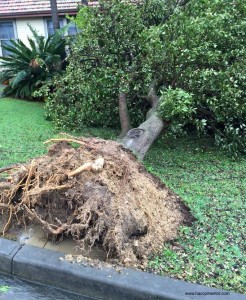Welcome to week 15 of the Food Safety HACCP Challenge. This weeks challenge is inspired by recent events in my home town in Australia. It really identified how underprepared we were when it comes to disaster contingency.
The background
The area where I live was hit by a natural disaster last week. The weather event, known as as an East-Coast low, produced winds of a category 2 cyclone with wide spread flooding. Houses were swept away, trees uprooted, buildings damaged and essential utilities cut too many businesses. From a domestic and small business standpoint, you don’t realise how much you depend on electricity until it is taken from you. Five days without power certainly impacted my family and business with no computers, no phones, no lights, no hot water and no electrical appliances. At best, we were prepared for a maximum of two days without power.
Disaster Contingency in your Food Business
This challenge is based around disaster contingency. How prepared is your business for a disaster? Do you have a disaster contingency plan in place? Do you have a backup power / water / gas source? Can your business operate on a minimum staff level? Do you have an alternative communication method?
This week I want you to review your disaster contingency plan for three key elements – Preparation, Response and Recovery.
1. Preparation
Preparation involves planning for disruptions within your food business. These include disruptions caused by major events such as floods, earthquakes, fire or other natural disasters and also minor incidents related to loss of data, people, customers and suppliers.
2. Response
Response covers how your food business will respond during an actual disaster, event or incident.
3. Recovery
Recovery is all of the actions your food business will take to get back on track after an event has occurred. It is about returning to business pre-disaster.
How to complete this Challenge
Step 1: Get a copy of your food business contingency plan. Now is a good time to start developing your disaster contingency plan if you do not already have one.
Step 2: Go through the document and see if the three key elements of preparation, response and recovery have been covered.
Step 3: If you find areas missing, go through and rectify.
Considerations of a Disaster Contingency Plan
Here a few areas that I have included in the disaster contingency plans that I develop for my clients:
- Overview
- Responsibility
- Crisis Management Team
- Crisis alert contact list
- Incident identification, assessment and management
- Isolate, identify and verify affected product
- Business resumption
- Business Continuity Plan Testing and Review
- Staff training and awareness
If your current disaster contingency plan is only 1 page – you have probably missed a lot of the key areas. The key to getting through any type of major incident or disaster is to be prepared. The more planning and preparation that you do, the less impact it will have on your food business response and recover.
Share your feedback
How did you go? Did you have a disaster contingency plan documented already? Did it cover all of the key elements? Will your business survive an event? Can you calculate the impact that a natural disaster would have on your food business? Let me know and share your thoughts on this #FSHChallenge by leaving a comment below.



